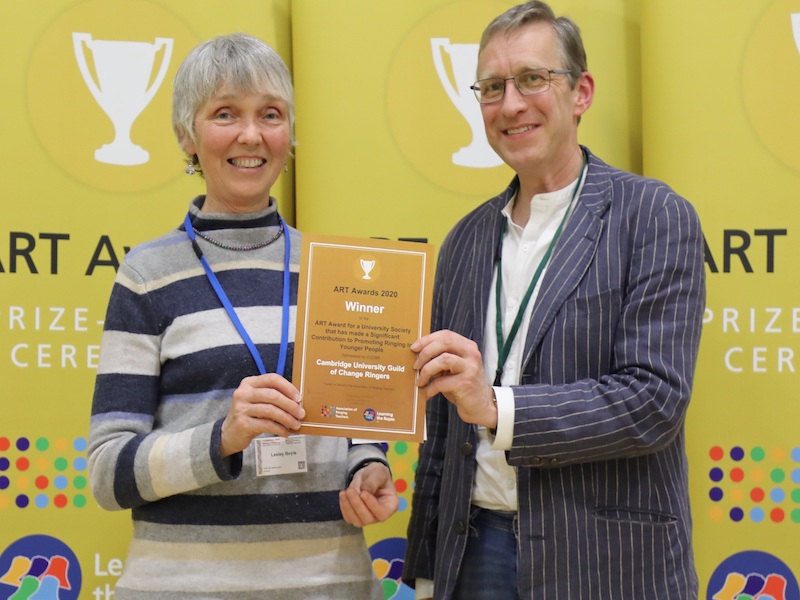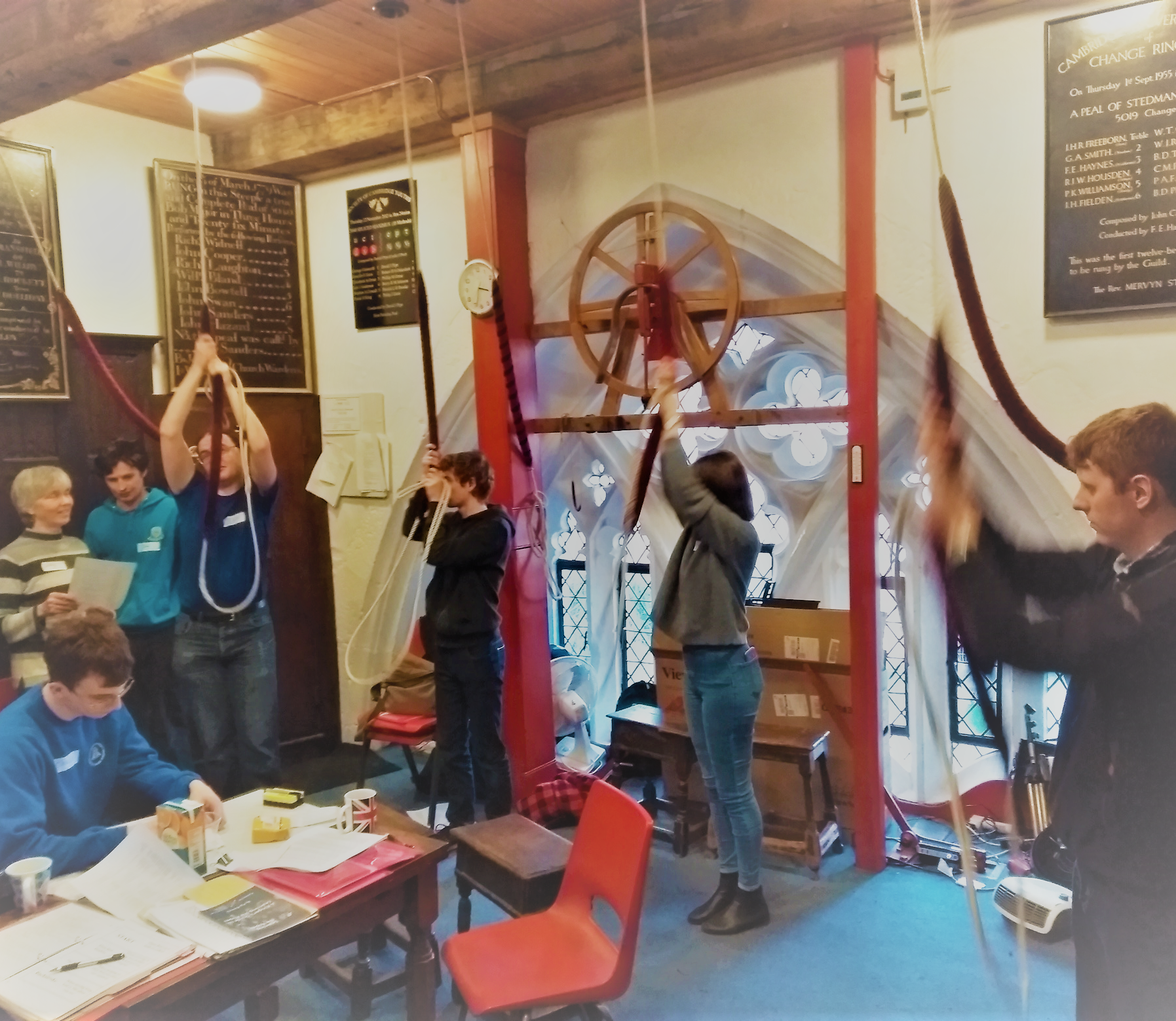The ART Award for a University Society that has made a Significant Contribution to Promoting Ringing to Younger People – Cambridge University Guild of Change Ringers
Background
Cambridge University Guild of Change Ringers (CUGCR) has activities for ringers of all abilities, from complete beginners through to those with years of experience. Activities include taster sessions, lessons for beginners, practice nights, service ringing, peals and quarter peals, handbell ringing and plenty of socials. The society itself is 140 years old, and has always had a strong presence in Cambridge. However, the boosted efforts to attract and teach new ringers is a far more recent development, started in 2016 by the Guild Master at the time.
The CUGCR has a diverse membership: about 15 students lie at the core who meet and ring regularly. Academic staff and graduates who live locally also ring regularly with them, and they also stay in touch with alumni across the country who join them on their annual dinner day. This term they had 26 curious people at the ‘Have a Go’ sessions at the start of term and then the teaching programme throughout term saw a total of 13 different teachers give lessons to a total of 21 keen beginners, of whom 11 were still ringing at the end of the term. The bulk of active members are students in Cambridge, so are mostly in the 18-25 age bracket.
Weekly practice nights happen every Thursday and Friday, with additional service ringing taking place on Sunday morning and afternoon. Throughout this term lessons were offered to new ringers every Tuesday, Friday and Sunday.
The CUGCR enjoys close links with the Society of Cambridge Youths, with whom they share one of their towers and ring with regularly. Their friendly relations with the Youths helps them at both ends of the ringing spectrum; as well as sometimes assisting them with their teaching (for example when they were low on teachers due to many students being at the SUA), students wishing to progress their twelve bell ringing are always warmly welcomed at their weekly practices. Around five of the current student guild regularly attend Youths’ practices.
Achievements
Teaching new ringers is now firmly a key part of the CUGCR activities. Last year saw the creation of Teaching Officer as an official committee position, nearly half of the ringing activities are teaching sessions and several of their most active members learnt to ring there. However, the end of the last academic year saw nearly half of their number leaving Cambridge, including two of their most experienced teachers. For the first time
since they began large scale teaching, the vulnerability of a University Society to rapid change in fortune was really highlighted. Despite the extra challenge, teaching has continued to maintain drive and has become more formalised, helped by an ART Module 1 course in September, and they are continuing to look to improve their teaching, in particular progressing learners into change ringing, hence why they are doing an ART Module 2 course in January.
Recruitment for the academic year began at the freshers’ fair with the Charmborough Ring. This undeniably made their stall big enough, loud enough and unique enough that it was pretty hard to miss! As well as making it very easy for existing ringers to find them, it gave a clear and exciting snapshot of what they do to thousands of people who’ve perhaps never even heard of change ringing before. Over the course of the two days, hundreds of fair attendees are given a go at ringing, many many flyers are handed out and those running the stall become very well-rehearsed in citing the details of the ‘Have a Go’ sessions that weekend! They reaped the rewards of having the Charmborough Ring with a total of 133 people signing up to the learners mailing list.
The first weekend of term saw them running two ‘Have a Go’ sessions, one on the Saturday and one on the Sunday with the aim that two separate days would allow as many as possible to come along. The 26 who attended across both sessions were each given their first go on tower bells, as well as a few fun exercises on handbells. The attendees also had a tour of the tower, including seeing the bells, the spectacular view from the top, and the opportunity to ask questions and chat with current guild members. Three of those who learnt with the guild last year were involved in running the taster sessions, proving to the prospective ringers that, despite seeming difficult at first, ringing is a skill that can be picked up well within the timespan of a university degree, thus helping to dispel concerns people may have had about joining the guild as absolute beginners.
After these sessions, registration was opened up for the programme of lessons. Learners were able to attend up to three lessons each week: Tuesday evening, Friday evening (before the usual guild practice) and on Sunday afternoon (before evensong ringing). The success of the recruitment efforts, as well as the flexibility of the programme on offer, meant they had 21 learners coming along to lessons. At each lesson the learner to teacher ratio was either one-to-one or very close to this; along with the use of handbells, this meant learners were never sitting out for extended periods. Lessons have also benefited from use of the simulator. This is very helpful for allowing some learners to ring as part of a band while others are still focusing on handling.
One thing that has been introduced this year is giving learners the ART Learning the Ropes Personal Progress Logbooks. This was done after discussing with some of last year’s learners whether they thought they’d be beneficial and how they might be best used. As well as helping to give learners a sense of progress and objectives to work towards, the logbooks are also helpful for teachers to know where to begin a lesson from. This is a particular benefit in the CUGCR teaching set-up where learners are often taught by a different teacher each session. They are also now registered as an ART Teaching Hub.
As well as teaching handling and introducing some theory with handbells, they have also tried to make sure that learners feel part of the guild as a whole. Having teaching sessions directly before regular ringing makes it easy to invite learners to stay and ring some rounds with the rest of the guild, as well as allowing them to meet members not involved in teaching. Socials have also helped, these have ranged from dinners and pub trips to a game night, an escape room and a film night, and then Christmas dinner rounded off the term. The fact that two learners brought along friends later in term, adding three more learners to their number, implies there have hopefully been some good word of mouth reviews! Term finished with eleven learners still ringing and most of them now ringing rounds.
As well as many new learners there has also been success in other areas. Four new existing ringers have been gained. This has been helped both by socials and also the breadth of ringing opportunities offered– with ringing at so many different times in the week, students are able to integrate ringing into their busy schedule with ease. Additionally, one of these freshers has been helping with teaching and another of them intends to next term. Meanwhile those who learnt last year have continued to progress. Three rang their first quarter before the annual dinner in March and this term has seen two second quarters (one of them away from cover) and a focus on plain hunt and plain bob. Additionally, one of last year’s cohort has been helping out with teaching this term by doing handbells and helping with following exercises. They are lined up to be the next Teaching Officer. (It isn’t necessary for the Teaching Officer to teach any handling. Their role is to organise and promote lessons, thus taking responsibility off other teachers so they may more easily devote their spare time). Their experience as both a learner and helping with teaching will be beneficial in determining whether there is anything that needs doing differently with next year’s teaching.
Future Plans and Aspirations
Even though some of the learners are now joining regular practices, they would like to continue to have teaching sessions next term so that the many learners wishing to continue may all do so in the environment that suits them best. This will kick off in the first week of term in January with a “ringing bootcamp”, where they will be reinforcing and building on the skills already learned in 3 sessions on 3 successive days. Towards the end of term, some learners will hopefully be ringing their first quarter peal on the annual dinner day as has been done in previous years.
Perhaps the main weakness of teaching efforts so far has been the progression of learners into change ringing. An ART Module 2C course is planned in January which should help. Additionally, there may be a need to perhaps consider arranging some special sessions focusing exclusively on plain hunt. Hopefully this may help faster progression than just getting a couple of attempts at a practice each week.
For it to be possible to run large scale teaching within the confines of what is already an incredibly busy term time, inevitably a lot of members have to be involved in teaching. By encouraging members to give teaching a go, hopefully they can then teach many others across the country in the years after they graduate. Teaching within a group setting means that other teachers can be asked for advice. It’s easier to get training such as ART courses and one can teach without needing to do any organising. This all contributes to ringers, who perhaps wouldn’t otherwise, taking their first teaching steps - confidence can be gained in a group setting before doing any teaching as a lone teacher. There is also an opportunity to try handbell ringing and it’s been found to be a fantastic medium for learners and more experienced ringers to ring together. As well as handbells coming out at busier Friday practices and being used in teaching, there is also a handbells Facebook group which anyone can use to self-organise small group practice sessions.


